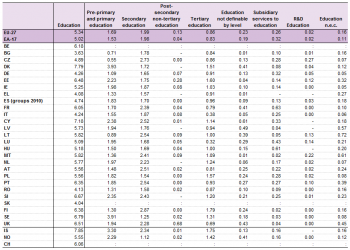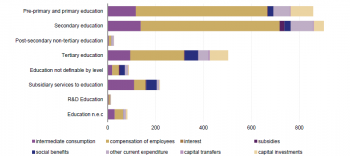Archive:Government expenditure on education - 2011 results
The level of government expenditure on education varies between Member States
Statistics in focus 12/2013; Authors: Laurent FREYSSON, Laura WAHRIG
ISSN:2314-9647 Catalogue number:KS-SF-13-012-EN-N
This article is outdated and has been archived. For recent articles on Government finance, please see here,
In the framework of the European System of National Accounts (ESA95), Eurostat collects data on general government expenditure by economic function according to the international Classification of the Functions of Government (COFOG) – see chapter Data sources and availability. This publication presents for the first time detailed COFOG data on education for the EU-27, presenting data by level of education. This became possible due to progress in the availability and quality of voluntarily transmitted COFOG level II data.




Main statistical findings
In 2011, EU-27 total general government expenditure amounted to 49.1 % of GDP. Based on the latest available expenditure data by economic function for 2011, 5.3% of GDP was devoted to expenditure on education. Of this, the highest shares were dedicated to ‘secondary education’ at 2.0 % of GDP and ‘pre-primary and primary education’ at 1.7 % of GDP.
EU-27 general government expenditure on education at 5.3 % of GDP in 2011
Government expenditure on education amounted to around EUR 347 billion in 2011 in the EU-27, or 5.3 % of GDP. Government expenditure on education compared to expenditure on education by private households, non-profit institutions serving households, corporations and non-domestics units can be expected to vary significantly across Member States and EFTA countries. The figures reported for general government should thus not be interpreted as an indicator of total expenditure on education in a country.
As a ratio to GDP, the highest levels of government expenditure on education among the reporting countries were found in Iceland (7.9 % of GDP), Denmark (7.8 % of GDP) and Cyprus (7.2 % of GDP). Among these countries, Denmark has a generally high level of government expenditure, while in Cyprus and Iceland, the level is notably low. Education had the highest weight in government expenditure in Estonia (16.9 % of total expenditure), followed by Iceland (16.7 % of total expenditure). The lowest ratios of government expenditure on education to GDP were observed in Bulgaria (3.6 % of GDP), Slovakia (4.0 % of GDP), Greece and Romania (both at 4.1 % of GDP). In Germany and Italy government expenditure on education was also below average. In Romania, the low ratio stands after a substantial increase in expenditure on education from 2010 to 2011. In 2010, it stood at 3.4 % of GDP.
Pre-primary, primary and secondary education
‘Pre-primary and primary education’ corresponding to ISCED levels 0 and 1 and secondary education, corresponding to ISCED levels 2 and 3, make up the largest part of government expenditure on education in the EU-27 and in most reporting countries. In the EU-27 as a whole, these two COFOG groups together account for 69 % of expenditure in COFOG division education’.
In 2011 in the EU-27, the share of ‘tertiary education’, corresponding to ISCED levels 5 and 6, in the division’s total expenditure stood at 12 %. ‘Tertiary education’ had a high weight in total government education expenditure in Poland and Finland (28 % of education expenditure) and Norway (26 %). ‘Post-secondary non-tertiary education’ accounted for only 2 % of total government expenditure on education in the EU-27; however, it had a relatively large share in government education expenditure in the United Kingdom (10 % of total government education expenditure).
Government expenditure on education decreases from 2009 to 2011
As a ratio to GDP, government expenditure on education followed a declining trend from 2002 until 2007 and then increased sharply from 2008 to 2009, mainly due to decreases in GDP at current prices. Active measures to consolidate government expenditure, such as pay cuts in a number of Member States and decreasing public investment contributed to a decrease of 0.2 percentage points of government education expenditure in terms of GDP from 2009 to 2011. An absolute decrease in general government gross capital formation (GCF) is noted for education from 2010 to 2011, in line with a total general decrease in government GCF. In absolute terms, education expenditure continued to grow, although the year-onyear growth was lower from 2010 to 2011 than in previous years. In ten Member States, a decrease in absolute expenditure on education (in local currency terms) is observed between 2010 and 2011: Denmark, Ireland, Greece, Spain, Italy, Cyprus, Hungary, Portugal, Slovakia and the United Kingdom.
Compensation of employees
Compensation of employees is the most important component of education expenditure. In the EU-27, ‘compensation of employees’ accounted for the largest share of education expenditure in most COFOG groups related to education (55 % of education expenditure). In the COFOG group ‘subsidiary services to education’, which includes for instance school transport and meals, ‘intermediate consumption’ accounted for a large part of expenditure. Apart from ‘compensation of employees’, ‘intermediate consumption’ and ‘capital investments’ (for instance school buildings) are important expenditure components.
Data sources and availability
This chapter gives some background information on the data sources as well as on the methodological concepts and technical terms and codes used. More exhaustive information and additional data can be found on Eurostat's website in the section dedicated to government finance statistics as well as on the Statistics Explained page dedicated to government finance statistics.
Provisional data: Data for BG, EL, HU, IS and SE (2011 only) is provisional.
Country notes: DK: Due to the structure of the Danish education system, the primary education is not divided into two levels. Therefore, the COFOG education data on primary education, 09.1 is composed of COFOG 9.1 primary education and 9.21 Lower-secondary education. COFOG group 09.2 is composed of COFOG 9.22 Upper-secondary education only.
Definition of general government and its sub-sectors: The data relate to the general government sector of the economy, as defined in ESA95, paragraph 2.68: 'All institutional units which are other non-market producers [institutional units whose sales do not cover more than the 50 % of the production costs, see ESA95 paragraph 3.26] whose output is intended for individual and collective consumption, and mainly financed by compulsory payments made by units belonging to other sectors, and/or all institutional units principally engaged in the redistribution of national income and wealth’.
Classification of functional expenditure of government: The Classification of the Functions of Government (COFOG classifies government expenditure into ten main categories (divisions known as the 'COFOG I level' breakdown): general public services; defence; public order and safety; economic affairs; environmental protection; housing and community affairs; health; recreation, culture and religion; education; social protection. These divisions are further broken down into 'groups' (COFOG II level). Further information is available in the Eurostat 'Manual on sources and methods for the compilation of COFOG Statistics' .
COFOG level II data: COFOG level II data is published only in agreement with the country concerned. The development of COFOG level II data is not completed in many Member States and data needs to be looked at with this in consideration. For BE and SK, COFOG group data is available but not published. For ES, COFOG group data is available for 2011, but not published pending the availability of more final data.
Satellite accounts: Administrative expenditure data is additionally collected in so-called satellite accounts. For education, the relevant collection is UOE (UNESCO-UIS/OECD/EUROSTAT data collection). In general, the amount of expenditure recorded in satellite accounts is expected to exceed the expenditure recorded under the respective COFOG division, as the COFOG classification focusses on recording expenditure by primary function. The comparability of UOE with COFOG data is explored in the COFOG manual.
Definition of general government expenditure:Government expenditure is defined in Commission Regulation 1500/2000 and use as reference a list of ESA95 categories:
Government expenditure comprises the following categories:
- P.2, 'intermediate consumption': the purchase of goods'and services by government;
- P.5, 'gross capital formation' consists of: (a) gross fixed capital formation (P.51); (b) changes in inventories (P.52); (c) acquisitions less disposals of valuables (P.53); where
- P.51, 'gross fixed capital formation': consists of acquisitions, less disposals, of fixed assets during a given period plus certain additions to the value of non-produced assets realised by the productive activity of producer or institutional units. Fixed assets are tangible or intangible assets produced as outputs from processes of production that are themselves used repeatedly, or continuously, in processes of production for more than one year;
- D.1, 'compensation of employees': the wages of'government employees plus non-wage costs such as social'contributions;
- D.29, 'other taxes on production, payable',
- D.3, 'subsidies, payable',
- D.4, 'property income, payable', consists of : (a) 'interest, payable (D.41) and (b) 'other property income, payable (D.42+D.43+D.44+D.45), where
- D.41, 'interest': excludes settlements under swaps and forward rate arrangements, as these are treated as financial transactions in the ESA 95;
- D.5, 'current taxes on income, wealth, etc, payable';
- D.62, social payments: cover social benefits and pensions paid in cash;
- D.6311, D.63121, D.63131, 'Social transfers in kind related to expenditure on products supplied to households via market producers';
- D.7, 'other current transfers, payable';
- D.8, 'adjustment for the change in net equity of households in pension fund reserves'
- D.9, 'capital transfers payable'
- K.2, 'acquisitions less disposals of non-financial non-produced assets': public investment spending. Non-financial non-produced assets consist of land and other tangible non-produced assets that may be used in the production of goods and services, and intangible non-produced assets.
Gross Domestic Product: Throughout this publication, nominal GDP, i.e. GDP at current prices is used.
'Time of recording & symbol: In the ESA95 system, recording is in principle on an accrual basis, that is, when ‘economic value is created, transformed or extinguished, or when claims and obligations arise, are transformed or are cancelled.'
Symbols:
- ":" not available
Context
Annual government finance statistics (GFS) data are collected by Eurostat on the basis of the European System of Accounts (ESA95) transmission programme. Member States are requested to transmit, among other tables, table 1100, 'Expenditure of general government by function' twelve months after the end of the reference period. Table 1100 provides information about expenditure of the general government sector divided into main COFOG functions and ESA95 categories. The transmission of the COFOG I level breakdown (divisions) is compulsory for the years 1995 onwards, whereas information on the COFOG II level (COFOG groups) is provided on a voluntary basis. The main reference years used in this publication are 2011 as the latest year available and 2002 as the first year for which complete data on expenditure by function are available at EU-27 level.
See also
- All articles on government expenditure
- Government finance statistics - quarterly data
- Integrated government finance statistics presentation
- Structure of government debt
- Tax revenue statistics
- Update of the SNA 1993 and revision of ESA95 (Background article)
Further Eurostat information
Publications
- COFOG Manual
- The level of government expenditure on education varies between Member States Statistics in focus 12/2013
Main tables
Database
- Annual government finance statistics (gov_a)
- General government expenditure by function (COFOG) (gov_a_exp)
Dedicated section
Methodology / Metadata
- Government revenue, expenditure and main aggregates (ESMS metadata file — gov_a_main_esms)
Other information
- Commission Regulation 1500/2000 of 10 July 2000 implementing Council Regulation No 2223/96 with respect to general government expenditure and revenue
External links